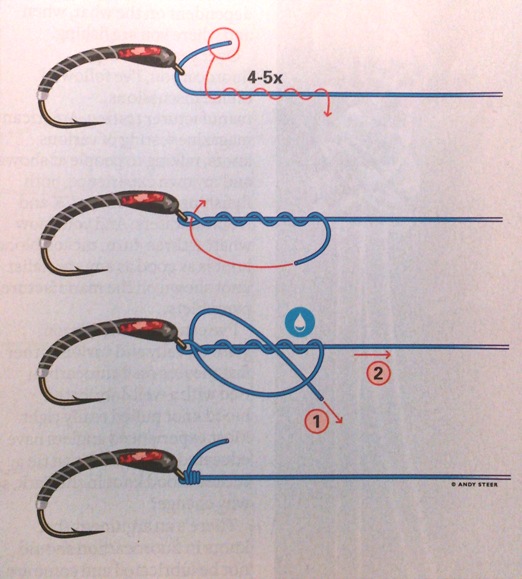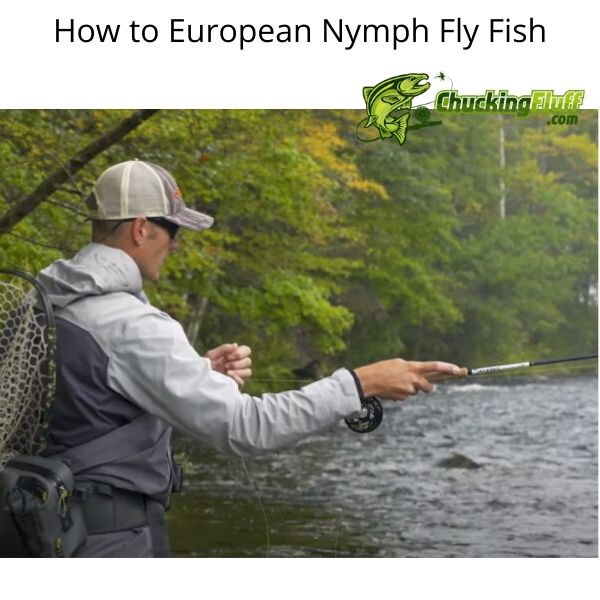| Disclosure: Just to be open and honest the buttons and links you click on in the website will in most cases take you to another website where you can purchase the products I am reviewing. As an Amazon Associate I earn from qualifying purchases. |
Best Fluorocarbon Fly Fishing Line – Stealth and Strength
Before we consider what is the best fluorocarbon fishing line let us discuss the properties and characteristics of this leader material.
When it comes to fly fishing the introduction of fluorocarbon may be one of the most outstanding developments since the creation of fly fishing itself.
I joke, but it really has made a large difference to fly fishing catch rates and fun to be had by anglers of all ages and skill levels.
Fluorocarbon has many properties but the one that makes it ideal for fishing is that light refracts through it the same way as water and so the fish (or so it is believed) can’t see it.
This is especially evident in still water fisheries as trout are usually leader shy and will move away from traditional monofilament lines.
This is where the fluorocarbon has helped get extra takes.
In river fishing especially fast water the light passing through it is refracted and distorted in numerous ways and the trout can’t see you or the line as easily as in calm still water.
So it is not that important but the other benefits make it ideal in these conditions also.
Quick Post Navigation
A tendency to be brittle!
Some fluorocarbon lines are very brittle but they can be compensated by getting the diameter that is correct for your type of fishing.
There are many brands and breaking strains so it may be a bit of testing to see what is ideally suited but we will discuss that later.
Fluorocarbon is usually a lot stiffer than mono and is great for the turnover on casts which helps in the reduction of wind knots, tangles and bad casting.
This makes it good for a beginner who is trying to learn fly fishing and also very good on weighted flies that have a tenancy to drop on the forward cast and catch the loop.
There is usually a lack of stretch in fluorocarbon at least it stretches a lot less than mono and so keeps you in better contact with your fly or lure.
This also helps set the hook quicker when a takes comes.
The one drawback is you can be broken easily if a trout takes hard while you are pulling especially on smaller braking strengths so it’s important to be careful as the line gets closer to you during the retrieve.
However, with fluorocarbon the fact that it is virtually invisible in the water you can get away with using slightly stronger and thicker strengths so snap offs can be reduced.
This all depends of course on the size of fly you are using as a twelve-pound line will not go through the smallest of hook sizes.
It sinks without applying xink?
Fluorocarbon sinks in water and is good to get weighted flies down to the bottom of a lake quickly.
It is also great on dry flies when using smaller diameters as the leader sinks without applying sinkant while the fly floats which is the desired effect.
Some anglers prefer mono in this case as it will not pull the dry fly under without constant re-application of float-ant.
Fluorocarbon is very tough and abrasive resistant when scrapping off rocks or underwater hazards which makes it ideal for fishing rivers and lakes.
If by chance the line gets kinked on anything a rub with a cloth or piece of leather will usually get the kink out.
Another good reason to use it. With mono, you would end up having to tie or change to a new leader.
How do you make fluorocarbon leaders?
Making a leader with fluorocarbon is similar to mono apart from the fact that the material is slightly more slippery and because of such knots need to be well secured.
Some anglers put on a spot of angling glue to the knot for this although a good idea I don’t feel it is necessary if you use the correct knots and tie them well.
As with all knots, lubrication is even more crucial to fluorocarbon to avoid burn and weakening of the knot.
I use water or surgeon’s knots for droppers and putting a loop on the end ready for tightening to the fly line by a loop to loop.
When tying on the flies I use blood knots with the end tucked in leaving the tag slightly longer than when using mono for slippage.
Fluorocarbon leader length!
Leader length is down to the type of fishing, the where and the when, but ideally, you want the leader to be the same length of the rod or in some cases slightly longer.
So for a trout rod of ten feet, you would be looking at nine to ten feet of leader.
If dry fly fishing you can extend this out to about fourteen or fifteen feet but you will need to taper it down a few times to get the proper turnover.
This can be a process of trial and error to see what length you can cast properly with the conditions you are fishing.
For instance, if it is particularly a windy day a long leader will become tangled very quickly and it would be better to fish one fly on a shorter leader maybe seven to eight feet that try to proceed with a longer one and spend a lot of time fixing wind knots and tangles.
Best fluorocarbon leaders
Many anglers have their own idea of what works for them when it comes to leader material but I have used a few over the last few years and have come up with a shortlist of my favorites,
- Seaguar fly leader
very expensive but worth it especially in the larger sizes I have used this in Russia and it didn’t let me down. Knot strength is good, turnover is excellent. The No 1 fluorocarbon used in the Kola Peninsula where the leader is vitally important with those big Atlantic salmon.
- Riverge, softer ideal for nymphing as it allows the fly to rise and fall more naturally while retrieving.
- Fulling Mills is a bit stiffer and ideal for blobs and dabblers while stripping and is a bit cheaper.
- Orvis Mirage
also a great soft leader material for dries and nymphs.
- Also on my list is SureCatch this material is fairly stiff and will suit both nymphing and pulling blobs. I have fished with it for the last several years and found the price tag is good for the quality of the leader you are getting. Knot strength is good as is turnover.
Beware however that softer thinner fluorocarbon is less tolerant of badly tied knots so make sure to tighten slowly and moisten with saliva.
I have heard some anglers say they don’t moisten Fluorocarbon but I have always done so and it works for me, try it both ways to test for yourself.
OK, there you have my take on fluorocarbon and why it is an invaluable addition to the fly fishing tackle bag.
As the caption says never leave home without it. Any comments or questions please leave them below and I’ll get back to you asap!





Hi mark, just a quick comment, when first starting out I used normal course fishing line, with not much success, Karl at dearnford hall put me on fluorocarbon, and I had instant success. Now I never use anything else.
Good to see it working for you, it does increase the take rate all you have to do it land them, 🙂
I have used Fulling Mill World Class for the past 20 years. It’s far and away the best. I have tried almost every other brand and always go back to World Class. Great value too.
Great line at a good price too.
I sometimes use copolymer in dry fly/surface fishing situations but it seems fatal to mix them as the break offs increase…. Anyone a comment to make?
Not sure of a good knot to do that, I prefer to taper down the fluorocarbon to my needs or buy a ready made tapered leader.
If I use copolymer I use nylon for the butt sections.
Thanks for the tip Shane sounds sensible.
One of the greatest advantages I find is the low diameter you can catch and release far quicker less stress on the trout, one of my favourite is 9.5 lb same diam as 5lb nylon. at the end of the season I cut the grass nd of my fly line off and use 1.5m of 15 lb needle knotted into my fly line I tie my leader into this and just chop it back as I go though the season it’s a lot neater and saves messing around it also makes your carbon fibre more forgiving to hard takes due to the stretch in the nylon.
I do something similar Steve putting a decent butt section on at the beginning and cutting back as it gets trashed. Good advice.
I’ve tried all sorts of fluorocarbon lines in an attempt to get the best tippet material for my casting ability or lack of shall we say. I’ve looked at very thin lines with a so called higher poundage breaking strain in an attempt to get flies down in the water column quickly. Granted these have not been dedicated fly tippet (LRF Flourocarbon) so I’ve learned not all fluorocarbon line will turn over your flies because the thinner material you go the more supple the line. This has always led me to return to branded fly fishing tippet material. It’s worth purchasing a quality tippet material as you’ll save money in the long run!!!. Thanks for your informative Blogs there’s something in them for everyone.?
Great tip David, go with branded material. I like Sightfree from Airflo at the minute when trout fishing.
Can I use a stiff leader with soft droppers is that an advantage ?
That’s a good question Tony. In my opinion I would prefer stiff droppers to keep the fly away from the main leader. A soft dropper will make the fly lie close to or on the main leader when retrieving and that will hinder trout takes. It’s not something I have tried myself, I tend to use the same material from the main leader and if I am tapering my leader I use the same breaking strain for that section for my droppers too.
I am in favor of minimalizing weakness in the leader especially at the knots and mixing dimensions or material types can do that particularly with fluorocarbon leader. I would suggest doing a a bit of testing to see if it works for you. Tie two droppers one with the same material one with the softer and see how it goes. Tight Lines!
I didn’t know what fluorocarbon fishing line was, but now I do! With continued input from you and Dom, one of these days I’m going to be a straight razor-shaving, fluorocarbon line-fishing fool. Please continue with these informative, entertaining articles. 🙂
There are many fly fishing anglers out there who haven’t heard of fluorocarbon leader material either Bill, you are not alone. I only came across it a few years ago and seen the benefits it was having to my catch rates so now I never leave home without it. 😉